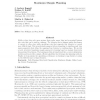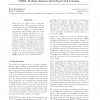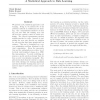ICML
2006
IEEE
16 years 1 months ago
2006
IEEE
An intuitive approach to utilizing unlabeled data in kernel-based classification algorithms is to simply treat unknown labels as additional optimization variables. For marginbased...
89
Voted
ICML
2006
IEEE
16 years 1 months ago
2006
IEEE
Feature selection is often applied to highdimensional data prior to classification learning. Using the same training dataset in both selection and learning can result in socalled ...
72
Voted
ICML
2006
IEEE
16 years 1 months ago
2006
IEEE
We explore the situation in which documents have to be categorized into more than one category system, a situation we refer to as multiple-view categorization. More particularly, ...
88
Voted
ICML
2006
IEEE
16 years 1 months ago
2006
IEEE
Sequence segmentation is a flexible and highly accurate mechanism for modeling several applications. Inference on segmentation models involves dynamic programming computations tha...
132
click to vote
ICML
2006
IEEE
16 years 1 months ago
2006
IEEE
Quadratic program relaxations are proposed as an alternative to linear program relaxations and tree reweighted belief propagation for the metric labeling or MAP estimation problem...
ICML
2006
IEEE
16 years 1 months ago
2006
IEEE
Mobile robots often rely upon systems that render sensor data and perceptual features into costs that can be used in a planner. The behavior that a designer wishes the planner to ...
93
Voted
ICML
2006
IEEE
16 years 1 months ago
2006
IEEE
Many applications of supervised learning require good generalization from limited labeled data. In the Bayesian setting, we can try to achieve this goal by using an informative pr...
86
Voted
ICML
2006
IEEE
16 years 1 months ago
2006
IEEE
We introduce the controlled predictive linearGaussian model (cPLG), a model that uses predictive state to model discrete-time dynamical systems with real-valued observations and v...
141
Voted
ICML
2006
IEEE
16 years 1 months ago
2006
IEEE
There has been much work on applying multiple-instance (MI) learning to contentbased image retrieval (CBIR) where the goal is to rank all images in a known repository using a smal...
106
click to vote
ICML
2006
IEEE
16 years 1 months ago
2006
IEEE
We present a new, statistical approach to rule learning. Doing so, we address two of the problems inherent in traditional rule learning: The computational hardness of finding rule...



